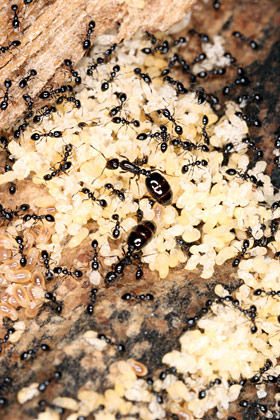Little Black Ant, Monomorium minimum

Benoit Guenard at http://www4.ncsu.edu/~bsguenar/Pics%20Monomorium%20minimum.html
IPM Steps to Reduce Little Black Ants
1. Sample for Pest
Before taking any action, confirm the presence of more than one ant—it may have come in on clothing or packaging. Inspect the adjacent areas along walls (interior and exterior) now and again later. An ant or two may be searching for a food source—don’t let them find it! Develop a knowledge of where ants are likely entering and make a practice to inspect and anticipate.
Where to find it while inspecting: Search for activity of more than one ant. Multiple workers (without wings) suggest a nearby, outdoor nest. Winged ants inside suggest a nest inside. If crushed, this ant can be identified by the foul odor sometimes described as like “rotten coconuts”. If desired, place a sticky trap on the floor in the area you suspect activity and check it the next day.
2. Proper ID
To best treat a pest, you must be sure what it is.
Size and Particulars: 1/16"–1/8" long (1.5–2 mm) (Queens 1/8") dark brown to black, thorax uneven in shape.
3. Learn the Pest Biology
Ants follow scent trails to and from food sources.
Life Cycle: Winged adults mate in spring through mid-July and form new colonies which can grow to 10,000; each colony may have several queens.
Preferred Food Sources: Feed on dead and living insects plus honeydew (aphid and scale feces), they forage homes for sweets. You may see them following trails to indoor food sources: grease, oil, meat, fruit, vegetables, and sweets.
Preferred Habitat: Live in shallow nests under debris, wood, and small stones, widely adaptable to greater habitat, will nest in wall voids and around sources of heat and moisture. Colonies can grow quite large.
4. Determine Threshold
If you’ve seen ant activity, you need to act.
Threshold: They can be difficult to control so any sighting of ant activity means you must act.
5. Choose Tactics
IPM for indoor pests is always a combination of exclusion and sanitation: Don’t provide access to water, food and shelter!
Best Management Practices: Keep all cracks and gaps in foundations, walls, windows and vents sealed. Keep plant and mulch debris away from foundation. Reduce moisture prone areas inside. The number one way to prevent ants is to remove any food source—keep food in containers and keep surfaces clean.
Treatment Methods: If a nest is found INSIDE, it must be removed. Call a professional or remove it by vacuuming with an industrial vacuum, (vacuum up some corn starch as well) and then destroy the vacuumed material. This will reduce but will probably not destroy all ants as a nest will contain a few dozen to a few thousand ants, and not all will be in the nest at the time. LOW TOXICITY METHODS: (do not use if you are also using a bait) Place near the nest: diatomaceous earth, a desiccant which dries out the insect bodies; pyrethrum products, a chrysanthemum derivative; silica, another desiccant sometimes sold in combination with pyrethrum; commercial products containing boric acid, an effective poison for insects with low toxicity to humans but must be used with extreme caution and may not be suitable or legal in your district. ALWAYS READ THE LABEL FOR ANY PRODUCT’S SPECIFIC DIRECTIONS. INSECTICIDE METHODS: Bait traps contain insecticide introduced in a food source. Due to the nature of the bait trap and the amount of insecticide, they are generally safe for use in schools. KEEP OUT OF REACH OF CHILDREN. For a bait to be effective you must 1) reduce any other access to a food source—sanitation and exclusion by keeping all foods in airtight containers. 2) do not kill ants when this type of food bait is out—they must carry the food bait back to the colony where it will be a deadly food source for the colony. You may see an increase in ants at first but then a slow decline. Do not spray insecticides at this time. Be patient. In severe infestations a professional may choose direct-to-nest and perimeter treatments.
6. Evaluate
Was the tactic successful? Record the date pests were first noted, and the tactic you used, and its success. Use one of our RECORD KEEPING tools.
For More Information:
Texas A&M AgriLife Research/Extension: Little Black Ant
Remember:
When a pesticide application is necessary, all necessary and required precautions are taken to minimize risk to people and the environment and to minimize risk of pesticide resistance or pest resurgence. Pesticide use in your school may be prohibited or regulated by local policies or state and federal regulations. Risk reduction methods can include, but are not limited to, spot-treatment, the use of gel or paste bait formulations placed in inaccessible locations, injection into a crack or crevice, and other methods that reduce potential exposure.